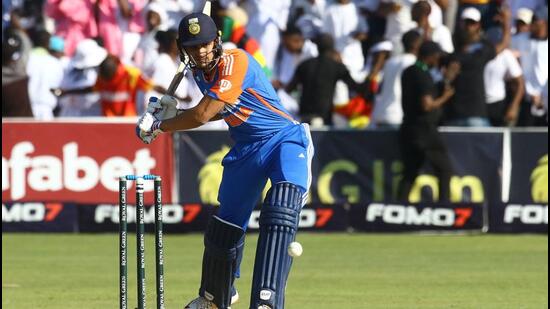
Time for Gill to showcase his all-format class
9 months ago | 101 Views
Kolkata: From standby in the T20 World Cup to vice-captain in both the white-ball formats might seem too big a stride, but it isn’t really for Shubman Gill. His initiation to captaincy was wobbly as Gill struggled to fill the hole left by Hardik Pandya but the pressure of the IPL no doubt was the best learning curve anyone could have asked for.
So, when the tour of Zimbabwe came calling with a second-string side, Gill stepped up and guided his team to a 4-1 win the T20 series last week. The ball had been officially set rolling.
“It is something that I definitely enjoy,” Gill had said in Harare when asked about his first tryst with India captaincy. “I think it brings out the best in me when I am out there because I look to be involved in the game. It is something that really brings out the side of me which I enjoy being on the field.”
Vice captaincy of the Indian cricket team is more of a titular position, but it intrinsically acts as a notice of BCCI’s leadership vision. And while the current scenario says otherwise, BCCI is known to be averse to split captaincy. And they normally like them young.
MS Dhoni was 26 when he was appointed captain of the T20 World Cup squad in 2007. As was Virat Kohli when Dhoni left Test captaincy during the tour of Australia in 2014. Still 24, Gill thus has considerable time to prepare himself for all-format captaincy. With Rohit Sharma—who will be 38 in April—still given the go, presumably till the Champions Trophy and the World Test Championship next year, it essentially translates to a year of internship for Gill before he is promoted in Tests and ODIs.
Which basically makes Yadav’s elevation to captaincy in the shortest format an interim move, and a clever one too since the next T20 World Cup is still two years away. Gill should open the batting—ideally with Yashasvi Jaiswal, a combination India could go forward across formats in the near future—as he has done for Gujarat Titans with considerable success. But big individual scores can be slippery measures in T20 and the BCCI has quite rightly decided to go with the 33-year-old Yadav who incidentally is also part of the Mumbai Indians team that Sharma had led till last season. The intention is clear: give Gill time to adjust to the rigours of T20.
What it might not tell you though is how silently India has once again bought the insurance of having at least one anchor type batter in the shortest format. Going all out has been the mantra of India’s batting for the last year or so but the T20 World Cup final in Barbados had shown the advantage of having a fallback, failsafe batting option. Virat Kohli retiring has thus paved the way for Gill to take up that spot.
It also reinforces the tried-and-tested formula of appointing a non-bowler as leader. Jasprit Bumrah’s supremacy is correlated to his fitness and the BCCI is clearly unwilling to push him for a job that demands, among many things, a certain level of continuity. Hardik Pandya had earlier been widely tipped as India’s next white-ball captain but with Gautam Gambhir—who is a strict advocate of all-format players—taking over as head coach, it now seems the board is not keen on giving him too wide a berth. The only other viable long-term option is Rishabh Pant, who Gill has interestingly pipped to the vice-captaincy spot. It’s an odd development since Pant not only is a non-bowler who ticks the all-format box, but is also extremely tactical. If there is any reason the BCCI could be a little iffy about Pant, it has to be the toll Delhi Capitals’ captaincy had seemed to take on his batting.
But Gill has been different, even in a season Gujarat Titans had finished eighth among 10 teams as he finished with 426 runs at a strike rate of 147.40 and a sensational hundred (104) against Chennai Super Kings. An ODI double hundred in 2023 heralded a phenomenal year where he became the quickest Indian to 1000 ODI runs and reserved his calmest for the World Cup semi-final against New Zealand at Wankhede, scoring an unbeaten 80 off 66 balls as the other batters took the attack to the bowlers in an imposing score of 397.
There was a lull in his Test scores but Gill couldn’t have found a better time to dig deep as he averaged 56.50 against a resilient England attack at home, backed by two hundreds that bore witness to extraordinary grit and technique in critical phases. Unperturbed and extraordinarily patient, Gill has often exuded the image of a batter who can make a difference with his composure. And the BCCI is expectedly hedging their bets in him keeping that in mind. Gill as all-format India captain makes sense at many levels, but not without its share of unknowns. That’s why the next 12 months could be crucial.
Read Also: how hillier helped jyothi find her light
#




















